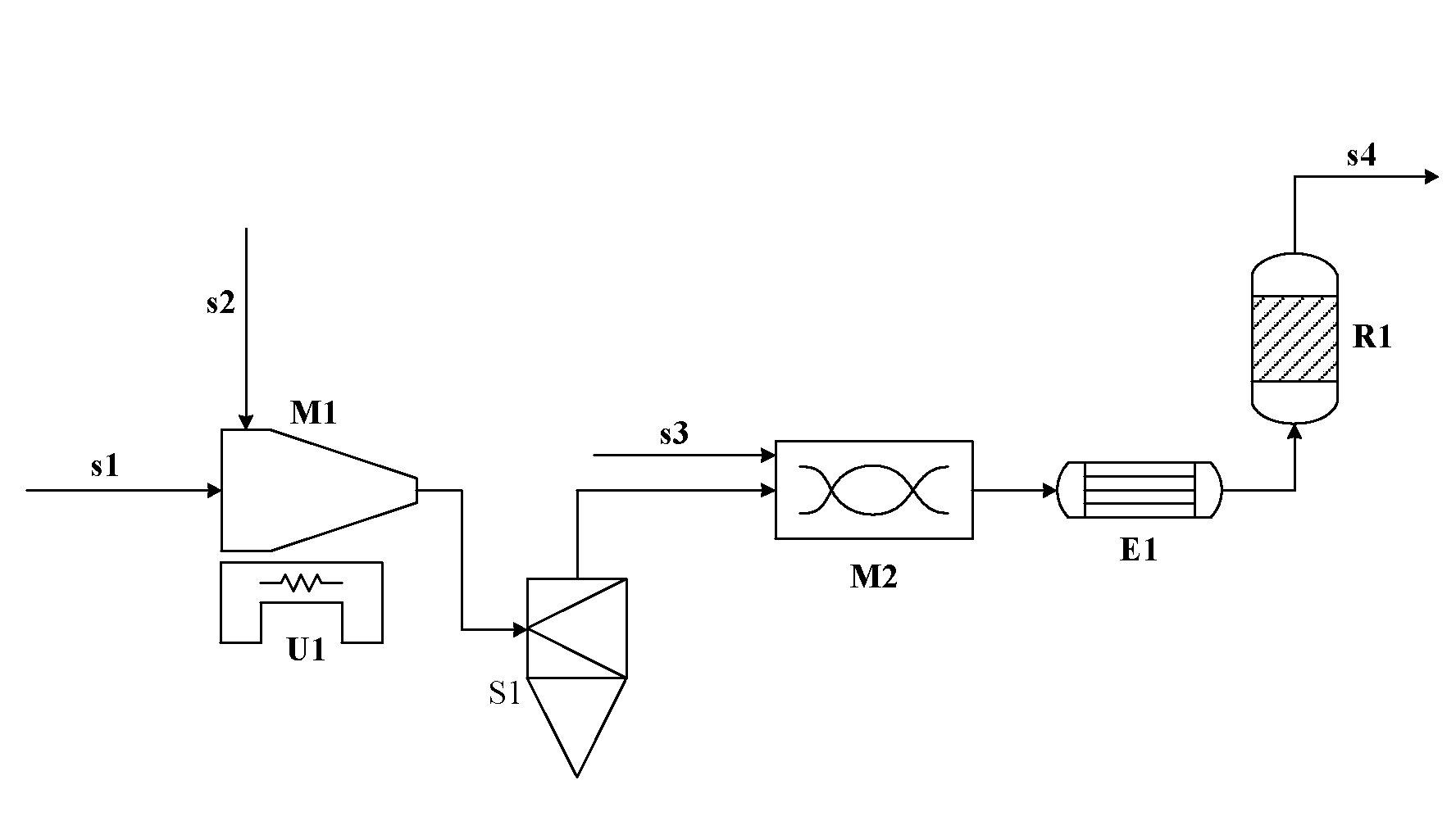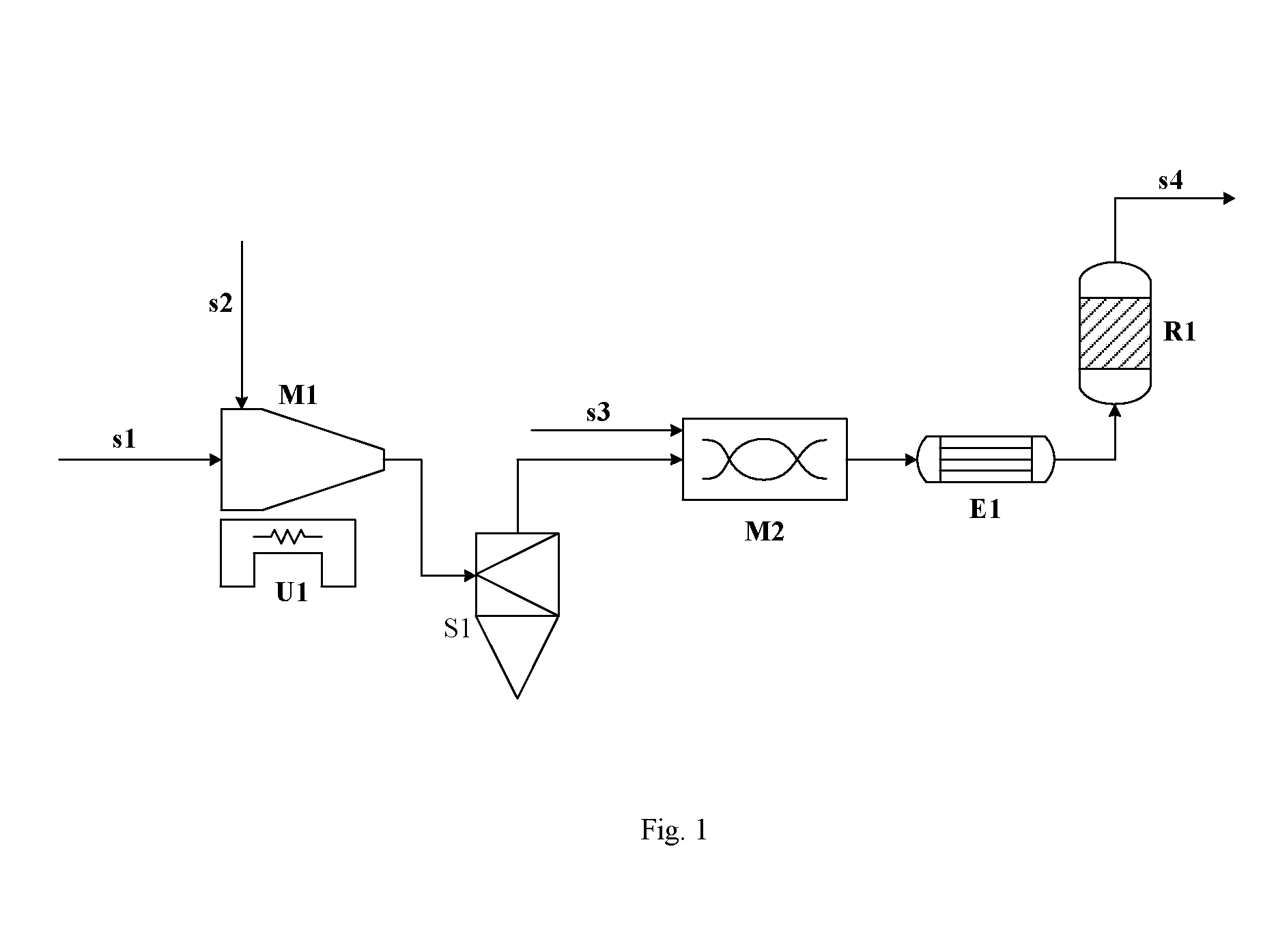Process of Producing Chlorine Gas by Catalytic Oxidation of Hydrogen Chloride
a technology of hydrogen chloride and catalytic oxidation, which is applied in the direction of chlorine/hydrogen chloride, chlorine production, chlorine/hydrogen chloride, etc. it can solve the problems of large surplus of sodium hydroxide, low utilization rate of chlorine atoms, and shortage of chlorine in the world. achieve the effect of accelerating reaction speed, promoting reaction, and promoting oxidation reaction
- Summary
- Abstract
- Description
- Claims
- Application Information
AI Technical Summary
Benefits of technology
Problems solved by technology
Method used
Image
Examples
example 1
[0063]Conduct the catalytic oxidation reaction using the same catalyst and the same reaction conditions as those of Comparative example 1, wherein the hydrogen chloride feed gas used is the unpurified crude hydrogen chloride gas obtained after phosgenation, i.e. the industrial crude hydrogen chloride produced in the process of preparing MDI (4,4′-diphenylmethane diisocyanate) from MDA (4,4′-diphenylmethane diamine) by phosgenation, which is determined to contain 425 ppm of chlorobenzene (mol / mol, based on hydrogen chloride) and a small amount of other organic compounds containing chlorine and compounds containing sulfur (the total content of these impurities is 0.05% (mol / mol, based on hydrogen chloride)). Before the hydrogen chloride gas enters into the reactor, introduce ozone at the rate of 10 L / hr of ozone (based on gaseous ozone) into the gas stream of hydrogen chloride by a jet disperser, the jet disperser comprises a jet (nozzle) section and a disperser section, wherein the d...
example 2
[0064]Conduct the catalytic oxidation reaction using the same catalyst and the same reaction conditions as those of Comparative example 1, wherein the hydrogen chloride feed gas used is the unpurified crude hydrogen chloride gas obtained after phosgenation, i.e. the industrial crude hydrogen chloride produced in the process of preparing MDI (4,4′-diphenylmethane diisocyanate) from MDA (4,4′-diphenylmethane diamine) by phosgenation, which is determined to contain 425 ppm of chlorobenzene (mol / mol, based on hydrogen chloride) and a small amount of other organic compounds containing chlorine and compounds containing sulfur (the total content of these impurities is 0.05% (mol / mol, based on hydrogen chloride)). Before the hydrogen chloride gas enters into the reactor, inject a hydrogen peroxide solution into the gas stream of hydrogen chloride by a micro-metering pump, and mix them in a pipe-line disperser having an internal diameter of 35 mm and a length of 700 mm, wherein the hydrogen ...
example 3
[0065]Conduct the catalytic oxidation reaction using the same catalyst and the same reaction conditions as those of Comparative example 2, wherein the hydrogen chloride feed gas used is the industrial purified hydrogen chloride as above, and 240 ppm of H2S (mol / mol, based on hydrogen chloride) is introduced to the hydrogen chloride by a mini-type gas flow meter. Before hydrogen chloride gas enters into the reactor, inject a hydrogen peroxide solution into the gas stream of hydrogen chloride in the same way as that of Example 2, and the pretreatment conditions and the conditions of subsequent catalytic oxidation reaction are also the same as that of Example 2. The oxidation reaction is conducted continuously for 100 hr, and the chlorine yield of 86.9%˜88.1% is obtained, without any obvious change of the catalyst activity. After 200 hrs of catalytic oxidation reaction, the solid particles of the oxidized impurities are discharged from the bottom of the cyclone separator. The present e...
PUM
| Property | Measurement | Unit |
|---|---|---|
| frequency | aaaaa | aaaaa |
| power | aaaaa | aaaaa |
| frequency | aaaaa | aaaaa |
Abstract
Description
Claims
Application Information
 Login to View More
Login to View More - R&D
- Intellectual Property
- Life Sciences
- Materials
- Tech Scout
- Unparalleled Data Quality
- Higher Quality Content
- 60% Fewer Hallucinations
Browse by: Latest US Patents, China's latest patents, Technical Efficacy Thesaurus, Application Domain, Technology Topic, Popular Technical Reports.
© 2025 PatSnap. All rights reserved.Legal|Privacy policy|Modern Slavery Act Transparency Statement|Sitemap|About US| Contact US: help@patsnap.com



